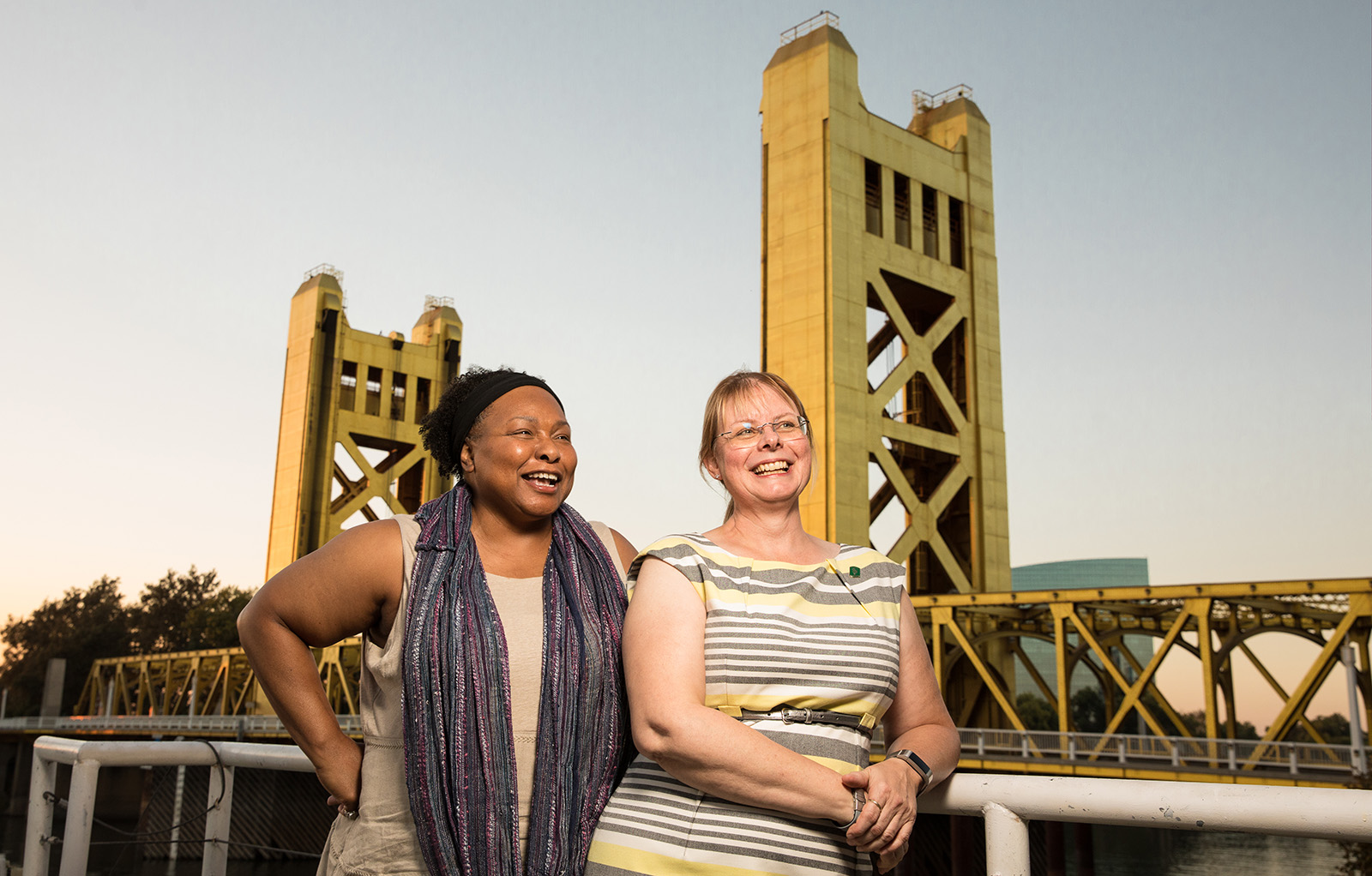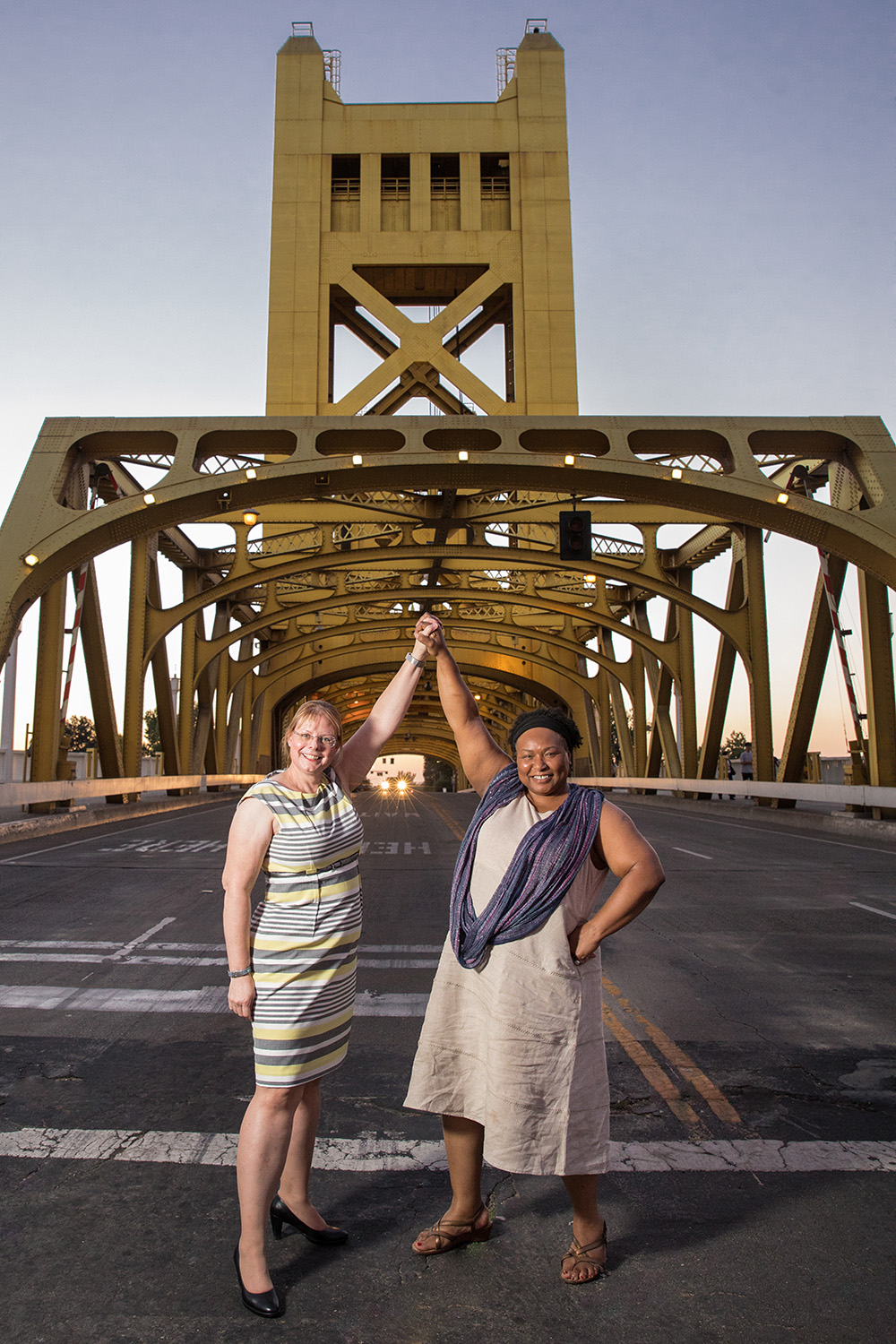

Building Bridges
Two new leaders look to span the region with innovations - one student at a time
Dixie Reid
“I don’t transport a vision. The vision depends on the culture here, what the University wants to achieve, where it wants to go. It’s clear that Sacramento State is moving in a direction that goes beyond it being just a teaching institution." - Yvonne Harris

Katherine Cota (left) and Yvonne Harris traveled different roads, but now that they are at Sacramento State, their experiences are fueling efforts to make research and engagement increasingly dynamic parts of the University’s place in the community and beyond. Photo by Andrea Price
Yvonne Harris grew up on Chicago’s south side and spent summers with her cousins, picking cotton on their grandparents’ Mississippi farm. Her parents encouraged her to find a life that would make her happy, so she pursued multiple degrees in science. Her doctoral emphasis was in molecular and cellular radiation biology.
Harris is the new associate vice president for Sacramento State’s Office of Research, Innovation and Economic Development (ORIED), where she oversees faculty research. Professors almost always partner with students, offering their protégés invaluable, real-world experience.
Katherine Cota was 12 when she launched a personal-services business in her Iowa neighborhood. She dreamed of becoming an engineer, but her high school guidance counselor said that wasn’t possible, because she was a girl.
She earned three degrees, none in engineering, but she got her MBA and is the founding executive director of Sac State’s new Dale and Katy Carlsen Center for Innovation and Entrepreneurship.
The center, founded with a $6 million gift from Dale Carlsen ’84 (Business Administration) and his wife, Katy, is meant to make Sac State more of a force for the regional economy and inspire generations of students to become critical thinkers.
Together, Harris and Cota are a dynamic new part of Sac State’s continuing emergence as a force beyond the University’s east Sacramento borders, a blossoming of research and engagement that supports its claim on the region as Sacramento’s “anchor university,” a place of influence and achievement, as well as continued and new connections.
Their sweeping vision, however, is based on a more intimate reading.
“Each person is able to define what is appropriate for them, for those in their community, and for the city as a whole,” Cota says.
Harris came to Sacramento from James Madison University, in Harrisonburg, Va., where she was vice provost for research and scholarship. Before she came to Sac State, Cota helped create the now-thriving John Pappajohn Entrepreneurial Center at the University of Northern Iowa, in Cedar Falls.
The two women arrived at Sac State three weeks apart last summer, quickly becoming friends and realizing they share a goal of making their new hometown a better place for all. They realize that Sac State is the right place to build bridges into the varied, important parts of the city and region.
“The cool thing about a comprehensive university like Sac State,” Cota says, “is that it allows for applied research, applied innovation, applied economic development and applied entrepreneurship.
“It’s about doing the research so that we can understand how it can be applied to benefit people, communities, governments, and economies.”
Harris says the results of research can be transformational, helping to pull people from economic poverty as well as from what she calls “poverty of the mind,” an extraction that can be accomplished with “understanding that the world is bigger than what you imagined.”
“When you have a global understanding of the world, there is nothing you can’t accomplish,” Harris says.
Anchoring the community
Harris, in addition to her leadership role with ORIED, is heading up Sac State’s partnership with the Promise Zone, a federal program meant to improve the quality of life for people living in high-poverty neighborhoods.
In 2015, President Barack Obama designated Sacramento one of the country’s eight new urban, rural, or tribal Promise Zones. Sacramento’s “zone” includes parts of midtown, downtown, south Sacramento, Del Paso Heights and north Sacramento.
Those economically hard-hit areas suffer from high unemployment and mortality rates. More than 30 percent of the adult residents in the zone did not finish high school, and nearly a quarter were foreign-born with limited English proficiency.
Sac State Downtown, which had its grand opening in August, is in the downtown Promise Zone and is expected to be part of ongoing renewal in the area.
“The Promise Zone has a deep reach into the communities that we also want to reach into,” Harris says. “Economic development to us is for those communities that haven’t been a part of the vision. The Promise Zone has an infrastructure we can map onto and build out from.”
But it must be done by people invested in those communities. Having outsiders land in a neighborhood and boast that they will show people there how to prosper is “arrogant,” Harris says, leaving bigger messes when they ultimately depart.
But many of Sac State’s students grew up in parts of the Promise Zone, so it makes sense for the University to support those communities. And when those students graduate, they can return home with the kind of knowledge that can lead to concrete changes in their neighborhoods.
“They go back with more power than someone who comes in from the outside,” Cota says. “We are giving students the tools they can use in an appropriate way for their community.”
Cota is working with Promise Zone partners on youth programs but focusing on students in third, fourth, and fifth grades, rather than the traditional middle school and high school target group.
She finds that 9- and 10-year-olds and “exceptional 8-year-olds” can be taught entrepreneurship with a simplified college-level curriculum.
“They are the most creative individuals,” Cota says. “They have not been corrupted to think they can’t do something. They create incredible ways of doing things because they don’t see boundaries.”
Harris says she believes that the modern education system is “designed to destroy entrepreneurship and innovation” and that, under it, students can be over-careful to avoid mistakes. By college, when they are encouraged to be innovative and entrepreneurial, they can’t, “because we have killed it.”
Cota remembers being reprimanded frequently by her first-grade teacher for getting out of her seat and talking to classmates. “In business,” she says now, “we call that networking.”
And Harris recalls when her younger daughter, then a fifth-grader, came home from school confused because a teacher marked every answer on her math paper as wrong. The child had the right answers, Harris says, but didn’t solve the problems the way the teacher instructed.
Point is, destinations often have several roads leading to them. And what is learned along the way can be powerful.
“Katherine and I really believe in this,” Harris says of their work at Sacramento State, embracing the reality that they “now are in a position to make change.”
“We’ve experienced the very things we don’t want others to experience, so we feel we’re in a position of empowerment. We’re now in a better position to make manifest in the world those things that we think are important.”
